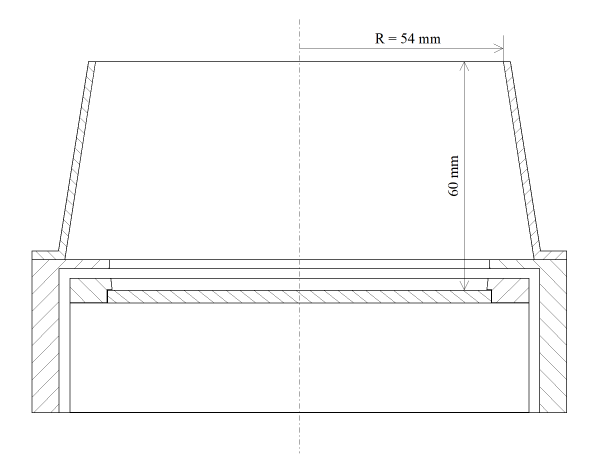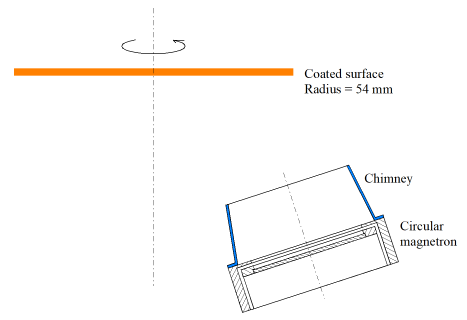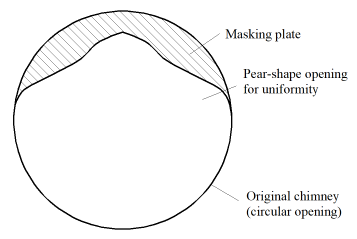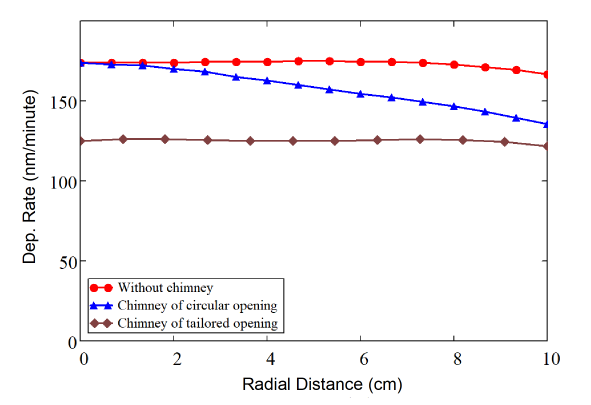NEWSLETTER July 2023
Chimneys for Vapor Source and Thickness Uniformity
In PVD, chimneys can be found with various vapor sources, including magnetron sputtering and evaporation sources. The purposes they serve also vary: a chimney may be employed to prevent spill over of vapor (to reduce cross contamination), to define a deposition zone in a substrate, or to limit the incidence angle of vapor impinging on substrates. In magnetron sputtering a chimney may be a part of the anode in some designs, and it can facilitate gas injection to form a pressure differential.
Whatever the primary purpose may be, a chimney alters the vapor flux that reaches the substrates, and consequently thickness distributions. Here we consider one example: a chimney over a 4-inch magnetron target with an circular opening of 54-mm radius and 60 mm deep, shown below.
Copyright © 2023 Tin Model LLC. All rights reserved.
This study has been carried out with a numerical simulation tool: V-Grade 5S Pro (Tin Model LLC). Please contact us for further details. We welcome all comments and questions about this study and on PVD in general.
Tin Model LLC, your partner in PVD innovations
(857)498-9723
155-M New Boston Street, Suite 142
Woburn, MA 01801, U.S.A.
www.tinmodel.com
Suppose that we would like to coat a substrate of 200-mm in diameter. In a "classic" arrangement, the cathode is positioned off center and tilt towards the center of the substrate, which undergoes a simple rotation, as shown in the following diagram. (For other examples of uniform coating with magnetron sources please view Case Studies.)
Before installing the chimney, the target can be positioned adeptly to achieve a thickness uniformity of +/- 2.4% over the radius. When the chimney is installed, the thickness distribution is altered drastically due to the partial blockage of particles that emit from the target at large angles, the corresponding nonuniformity worsens to +/- 12.4%.
To regain thickness uniformity with the chimney we have some options. The first is to reposition the magnetron relative to the substrate; the second option is to install a correction mask near the substrate; the third option, which we will demonstrate here, is to mask the chimney opening. The need of having a chimney should mean that further restriction of its opening may be acceptable, or even desirable. Shown below is a masking plate affixed to the chimney opening, reshaping it to a pear-like opening.
With the tailored chimney opening the thickness distribution is much more uniform. A comparison of the three cases is shown in the plot below. A tailored chimney opening can effectively correct the nonuniformity introduced by the circular-opening chimney. In this example, the pear-shaped opening reduces the nonuniformity to +/- 1.7% over the entire radius; from the center to a radius of 8 cm the uniformity is +/- 0.5%.
It should also be noted that a chimney reduces collection of vapor by substrates, which means a reduction of deposition rates. On the other hand, the pressure differential enabled by a chimney may allow the magnetron to operate under a more favorable conditiosn that promotes high deposition rates, in addition to other benefits.




